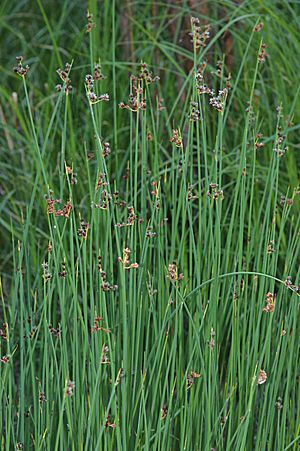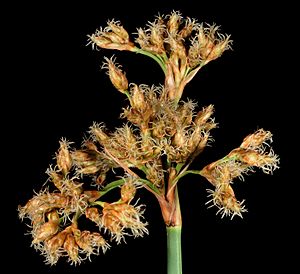Schoenoplectus tabernaemontani facts for kids
Quick facts for kids Schoenoplectus tabernaemontani |
|
|---|---|
 |
|
| Scientific classification | |
| Genus: |
Schoenoplectus
|
| Species: |
tabernaemontani
|
| Synonyms | |
|
List
Cyperus tabernaemontani (C.C.Gmel.) Missbach & E.H.L.Krause
Eleogiton tabernaemontani (C.C.Gmel.) Fourr. Heleogiton tabernaemontani (C.C.Gmel.) Peterm. Heleophylax tabernaemontani (C.C.Gmel.) Schinz & Thell. Hymenochaeta tabernaemontani (C.C.Gmel.) Nakai Schoenoplectus lacustris subsp. creber (Fernald) Á.Löve & D.Löve Schoenoplectus lacustris f. glaucus (Hartm.) Soó Schoenoplectus lacustris subsp. glaucus (Hartm.) Luceño & Marín Schoenoplectus lacustris subsp. tabernaemontani (C.C.Gmel.) Á.Löve & D.Löve Schoenoplectus lacustris subsp. validus (Vahl) T.Koyama Schoenoplectus tabernaemontani f. sub-duvalii (Beckh.) Soó Schoenoplectus validus (Vahl) Á.Löve & D.Löve Schoenoplectus validus subsp. creber (Fernald) Á.Löve & D.Löve Schoenoplectus validus subsp. luxurians (Miq.) Soják Scirpus glaucus Sm. Scirpus globifer Welw. ex Steud. Scirpus lacustris subsp. creber (Fernald) T.Koyama Scirpus lacustris f. glaucus (Hartm.) Peterm. Scirpus lacustris subsp. glaucus Hartm. Scirpus lacustris var. luxurians (Miq.) T.Koyama Scirpus lacustris var. tabernaemontani (C.C.Gmel.) Nyman Scirpus lacustris subsp. tabernaemontani (C.C. Gmel.) Syme Scirpus lacustris var. tabernaemontani (C.C. Gmel.) Döll Scirpus lacustris subsp. validus (Vahl) T.Koyama Scirpus lacustris var. validus (Vahl) Kük. Scirpus lacustris subsp. validus (Vahl) Osten Scirpus maritimus subsp. tabernaemontani (C.C.Gmel.) Nyman Scirpus siculus Lojac. Scirpus tabernaemontani C.C.Gmel. Scirpus tabernaemontani f. luxurians Miq. Scirpus tabernaemontani f. paludosus Boenn. Scirpus tabernaemontani f. sub-duvalii Beckh. Scirpus uliginosus Kar. & Kir. Scirpus validus Vahl Scirpus validus var. creber Fernald Scirpus validus f. creber (Fernald) Beetle Scirpus validus var. laeviglumis Tang & F.T.Wang |
|
Schoenoplectus tabernaemontani is a type of plant often called softstem bulrush, grey club-rush, or great bulrush. It is part of the sedge family, which includes grass-like plants. This plant grows in many parts of the world. You can find it in almost every state in the United States and every province in Canada. It likes to grow in wet places, like marshes or shallow water.
Contents
About the Softstem Bulrush
The softstem bulrush is a plant that can look quite different depending on where it grows. This is why it has so many different scientific names! It is a perennial plant, meaning it lives for more than two years. It grows in thick groups of many thin, straight stems.
What Does It Look Like?
The stems of the softstem bulrush can grow very tall, from about 1 to 3 meters (3 to 10 feet) high. The plant grows from a long underground stem system called a rhizome. This helps it spread and form dense patches. Its leaves are mostly at the bottom of the plant and wrap around the stems.
At the top of the stems, you'll find the plant's flowers. They grow in a cluster of small spikes called an inflorescence. These clusters are usually on long, thin branches that can spread out or hang down. The small spikes can be different colors. There is often a long, stiff leaf-like part next to each cluster of spikes.
Special Varieties
Some types of softstem bulrush are grown just for their looks. One popular type is called S. tabernaemontani 'Zebrinus'. It has bright white or yellow stripes across its stems, like a zebra! People often plant it in water gardens or for landscaping because it looks so pretty. You can also find varieties that are solid white or yellow.
Uses of the Plant
The softstem bulrush is not just a pretty plant; it can also be used for food. The new shoots, which are young stems, can be eaten raw or cooked. The young roots are also edible. Older roots can be dried and ground into a type of flour.
See also
 In Spanish: Schoenoplectus tabernaemontani para niños
In Spanish: Schoenoplectus tabernaemontani para niños


